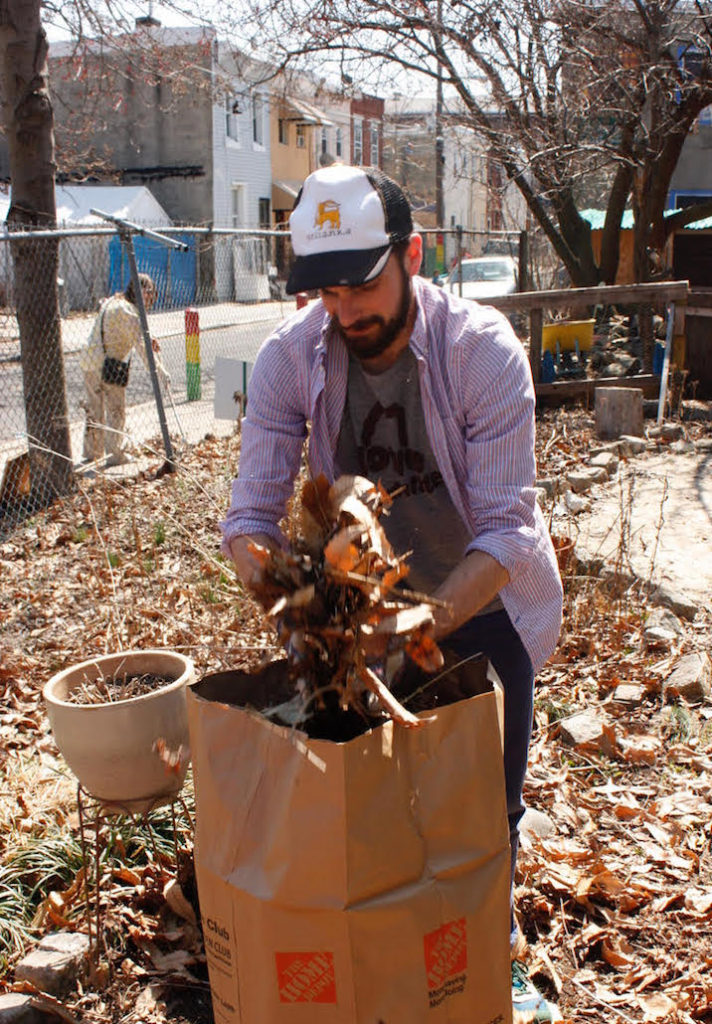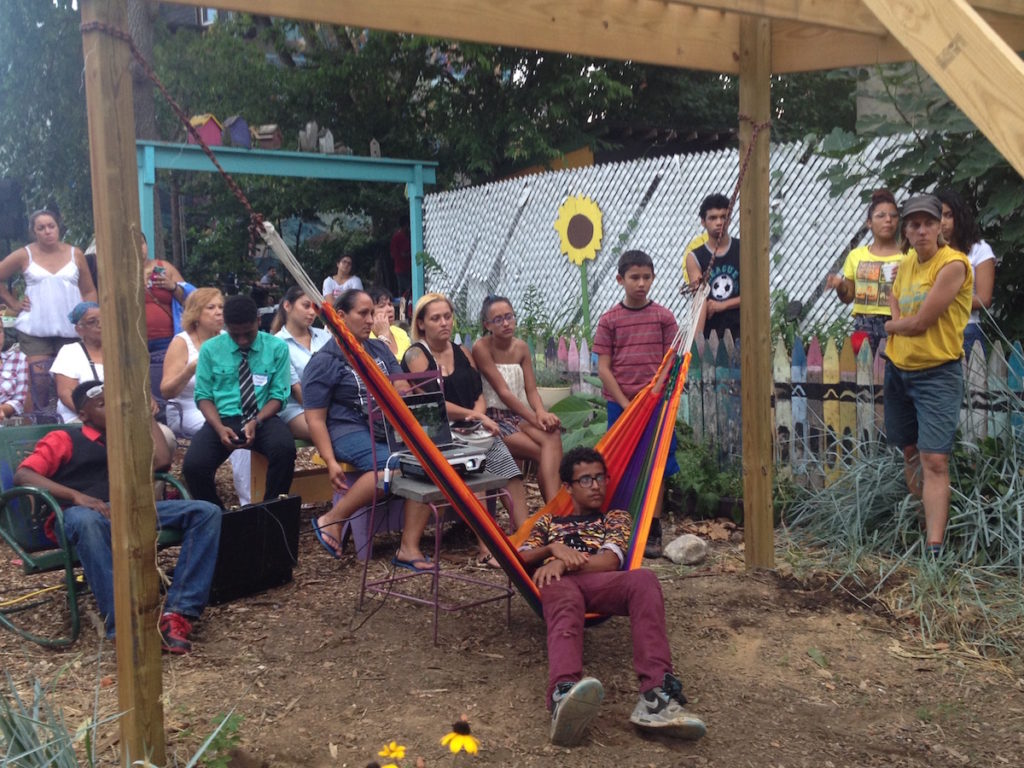Justin Trezza left Norris Square to make way for more ‘representative’ leadership
 August 8, 2017
Category: Featured, Long, People
August 8, 2017
Category: Featured, Long, People
“Moving On” is a series of Q&As with social impact leaders who are leaving their organizations for new opportunities. Here, they share what they learned and where they’re headed.
Justin Trezza didn’t expect to get hired as the executive director of Norris Square Neighborhood Project.
In 2013, he was two years into living in Philly and working remotely for a food security nonprofit in Central America. He began volunteering at Norris Square’s Las Parcelas in an effort to get to know the city’s urban farming community and later applied for the open ED position, looking for a new challenge.
He was surprised to get the offer because not only was he not from the neighborhood, he was white — and the North Philly community he was tasked with serving was mostly Latino.
Trezza discusses all of this willingly. The Peace Corps alum stepped down from the nonprofit last month after nearly four years at the helm partially to spend more time with his newborn, partially to take a break and consider what’s next, and partially because, in his own words, “I felt like I cannot continue to adequately represent the organization being a white, straight male when we’re serving mostly Black and brown youth.”
The organization hired Dr. Sandra Andino, an artist and cultural arts education consultant, to take over, which she did on July 31. It was a long transition process: Trezza began discussing the possibility of his departure with the Norris Square board in September, told his staff in January, and announced it publicly in March.
Generocity Editor Julie Zeglen spoke with him in his last few weeks at Norris Square. Their conversation has been edited for length and clarity.
###
Generocity: Why are you leaving?
Justin Trezza: Really, it’s two factors. The first factor was my wife and I had a child about a year ago. And that definitely altered my way of thinking, my work life balance, and I quickly realized that I have to be an effective, involved parent but also an effective leader. I need to make a choice here because one thing was going to suffer as a result of the other.
[And] it’s very important, especially in these times, that the organization has a [leader] representative of the demographics that we’re serving. I felt like I cannot continue to adequately represent the organization being a white, straight male when we’re serving mostly Black and brown youth, we’re serving a large LGBTQ population and it was time that someone that these kids could potentially relate to and can understand a little bit better [was leading].
I have a great relationship with all of our youth, but again, I think it’s important that they have a leader here that they can see a little bit of themselves in.
G: That’s something we’ve heard a lot of organizations or leaders generally talking about — how important it is to have representative leadership.
How would you advise other nonprofits considering leadership changes like this, either if they’re hiring or somebody is in your position and thinking of leaving? What should leaders in organizations ask themselves and how should they challenge themselves when considering their own leadership?
JT: I think first and foremost it’s very important to [consider] barriers when it comes to education [requirements]. Oftentimes we judge by the number of degrees they have rather than life experiences. The brightest people I’ve met might only have a [high school] diploma but they have massive amounts of real world experiences that can be very applicable to running a nonprofit. There’s no blueprint or right way of saying, “This person is going to be a good executive director.”
During my tenure here, I’ve tried to create a transparent environment where everyone has an equal voice here. I want everyone to play an equal role in terms of being a representative of the organization. I don’t necessarily want it to be me at the face of the organization. It shouldn’t be.
We juggled around [the idea of] the shared responsibility, kind of dual directorship, which we know Urban Creators has been doing. We’re not anywhere near that place yet, but I think looking further down that road, it might be an area the organization does consider.
G: Sandra Andino is taking over as executive director. What does that transition look like?
JT: The board decided to pursue the search on their own versus hiring a consultant. So, I think that also caused the process to take longer than anticipated. We all know that hirings are not easy. They take serious amounts of time and I think this time around the board was being really intentional about who it was that they selected.
They decided to pursue Sandra and I think a lot of it has to do with Sandra has rich ties to this neighborhood, Philadelphia. She’s been in the city for over 20 years, has ties to a lot of the women that started the garden, especially Iris Brown, and I think that was very important for the board to continue those relationships and build upon them.
But I shared with her that I’m happy to continue to play a role and support her as well as [serve in an] advisory role for a short time as she transitions and familiarizes herself with things.
G: You mentioned separately to me that during your time at Norris Square, the organization was able to reduce its debt, partially by shutting down its elementary and middle school programs to focus more on the high school program, further consolidating other programs to just focus on your organizational strengths, i.e. a garden apprenticeship program that mixed culture and arts, selling property, etc.
What were some other concrete steps that were taken?
JT: Something else that really helped was, we were able to increase the number of multi-year grants. Although we weren’t using those grants to pay off debt, [they] allowed us to then utilize all of the unrestricted income to pay off debt.
And then this year, we entered into a partnership where we were providing classes to a Head Start program, which was another source of revenue — not a huge amount. Five, six thousand dollars more than we had budgeted. So there’s small things like that.
There’s a lot of room for the organization to generate other sources of unrestricted income, something we haven’t quite gotten to [at Norris Square]. If I had been here longer, part of the long-term plan was to build our own income, whether it was through garden rentals, additional workshops — I know students are taking more of an interest in entrepreneurship and creating products that are sold. So I think there’s opportunity through there that Sandra will continue to pursue.
G: What’s up with the Earthship?
JT: It’s mostly done. I think definitely come October, November, it will be fully complete. They’re putting insulation in the interior. It’s small but it’s taking a lot of work and we’re only working with a team of volunteers.
G: And Norris Square is rebranding, right?
JT: It was about six months ago we started the process. I think we’re going to be unveiling all of this shortly after Sandra starts here.
It’s almost going to an unveiling of a new Norris Square Neighborhood Project. It’s all of the same people, just a new executive director, a new website, we’re going to have a new logo, as well as a new mission statement. I think it’s going to be a nice fresh start for everyone. It’s been an engaging and challenging process but there’s been a lot of buy in recently.
G: Anything else you’d like to share?
JT: The one thing that I would share is that funders always go into panic mode when they hear about executive transitions. In fact, I’ve had funders that said, “Well, we’re going to hold on funding you because of this.” It’s just sad because now, more than ever, organizations need the support of their funders. You look at the for-profit world, there’s constant transition. We’re always holding nonprofits to this different standard.
###
Love stories like this? Have an idea of how we can do better? Take our annual readers survey here.
Project
Norris Square Neighborhood ProjectTrending News











